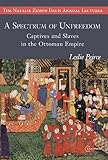A Spectrum of Unfreedom : Captives and Slaves in the Ottoman Empire / Leslie Peirce.
Material type: TextSeries: The Natalie Zemon Davis Annual Lectures SeriesPublisher: Budapest ; New York : Central European University Press, [2021]Copyright date: 2021Description: 1 online resource (134 p.)Content type:
TextSeries: The Natalie Zemon Davis Annual Lectures SeriesPublisher: Budapest ; New York : Central European University Press, [2021]Copyright date: 2021Description: 1 online resource (134 p.)Content type: - 9789633864005
- 306.3/6209561 23/eng/20230216
- HT1238
- online - DeGruyter
| Item type | Current library | Call number | URL | Status | Notes | Barcode | |
|---|---|---|---|---|---|---|---|
 eBook
eBook
|
Biblioteca "Angelicum" Pont. Univ. S.Tommaso d'Aquino Nuvola online | online - DeGruyter (Browse shelf(Opens below)) | Online access | Not for loan (Accesso limitato) | Accesso per gli utenti autorizzati / Access for authorized users | (dgr)9789633864005 |
Browsing Biblioteca "Angelicum" Pont. Univ. S.Tommaso d'Aquino shelves, Shelving location: Nuvola online Close shelf browser (Hides shelf browser)

|

|

|

|

|

|

|
||
| online - DeGruyter Promoting the Saints : Cults and Their Contexts from Late Antiquity until the Early Modern Period / | online - DeGruyter Our Man in Warszawa : How the West Misread Poland / | online - DeGruyter Underground Modernity : Urban Poetics in East-Central Europe, Pre- and Post-1989 / | online - DeGruyter A Spectrum of Unfreedom : Captives and Slaves in the Ottoman Empire / | online - DeGruyter Up in the Air? : The Future of Public Service Media in the Western Balkans / | online - DeGruyter Communist Gourmet : The Curious Story of Food in the People’s Republic of Bulgaria / | online - DeGruyter People in Spite of History : Stories Found in an Attorney Archive in the Banat Region / |
Frontmatter -- Table of Contents -- Preface -- Chapter 1. An Overview of Ottoman Slavery -- Chapter 2. Captives and Their Captors -- Chapter 3. Voices of Captivity in Legend, History, and Law -- Notes -- Bibliography -- Index
restricted access online access with authorization star
http://purl.org/coar/access_right/c_16ec
Without the labor of the captives and slaves, the Ottoman empire could not have attained and maintained its strength in early modern times. With Anatolia as the geographic focus, Leslie Peirce searches for the voices of the unfree, drawing on archives, histories written at the time, and legal texts. Unfree persons comprised two general populations: slaves and captives. Mostly household workers, slaves lived in a variety of circumstances, from squalor to luxury. Their duties varied with the status of their owner. Slave status might not last a lifetime, as Islamic law and Ottoman practice endorsed freeing one’s slave. Captives were typically seized in raids, generally to disappear, their fates unknown. Victims rarely returned home, despite efforts of their families and neighbors to recover them. The reader learns what it was about the Ottoman environment of the sixteenth and seventeenth centuries that offered some captives the opportunity to improve the conditions of their bondage. The book describes imperial efforts to fight against the menace of captive-taking despite the widespread corruption among the state’s own officials, who had their own interest in captive labor. From the fortunes of captives and slaves the book moves to their representation in legend, historical literature, and law, where, fortunately, both captors and their prey are present.
Mode of access: Internet via World Wide Web.
In English.
Description based on online resource; title from PDF title page (publisher's Web site, viewed 20. Nov 2024)


